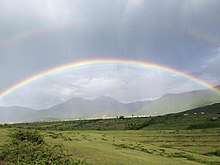Prende
Prende (also Prenne, Premte or Petka) is the goddess of love, beauty and fertility in the Albanian pagan mythology, who is thought to have been worshiped by the Illyrians in antiquity. In Albanian folklore she is the wife of the thunder and sky god Perëndi, and referred to as "Lady Prenne" or "Lady of Beauty" (Albanian: Zonja Prende or Zonja e Bukurisë, in Gheg Albanian: Zoja Prenne or Zoja e Bukuris), while her sacred day was Friday, named in Albanian after her: e premte.[2][3] Prende is identified with the cult of Venus and she was worshipped in northern Albania, especially by the Albanian women, until recent times. Originally a pre-Christian deity, she was called "Saint Veneranda" (Shënepremte), identified by the Catholic Church as Saint Anne, mother of Virgin Mary. She was so popular in Albania that over one in eight of the Catholic churches existing in the late 16th and the early 17th centuries were named after her. Many other historical Catholic and Orthodox churches were dedicated to her in the 18th and 19th centuries.[1]

Role
Prende is the goddess of love, beauty and fertility, the Albanian equivalent of the Roman Venus, Norse Freyja and Greek Aphrodite.[4] In Albanian mythology she is the wife of the thunder and sky god Perëndi.[3]
Practices
Prende was worshipped in northern Albania, especially by the Albanian women until recent times. Prende's festival was celebrated on July 26 every year, and her devotees would don beautiful clothing and would set out a mortar and pestle as a representation of sexual union. In Albanian folk beliefs the Rainbow is regarded as "Lady Prende's Belt".[1]
When Albania became Christianized in antiquity, Prende was identified by the Catholic Church as Saint Anne, mother of Virgin Mary, and was called "Saint Veneranda" (Albanian: Shënepremte or Prende, known in Gheg dialect as Prenne, Perende or Petka).[5] Another Albanian Christian saint thought by some to have a non-Christian origin is Gjin.
Prende was so popular in Albania that of the some 275 Catholic churches recorded to have existed in Albania in the late 16th and the early 17th centuries, 33 were named after her, more than to any other saint except Virgin Mary and Saint Nicholas. Many other historical Catholic and Orthodox churches were dedicated to her in the 18th and 19th centuries. In the Kurbin valley pilgrimages to the church of Saint Veneranda were common among both Christians and Muslims. There people went also in the hope of a cure for mental illness.[1]
As is usual in many cultures, in Albania the day sacred to the goddess of love is Friday, named in the Albanian language after her: dita e premte.[3][6]
See also
- Albanian mythology
- Illyrian religion
- En
- Perëndi
- Venus
- Freyja
Sources
Citations
- Elsie 2001, p. 258.
- Dunwich 2000, p. 151.
- Lurker 2005, p. 155.
- Treimer 1971.
- Elsie 2000, p. 43: "The third saint to be mentioned in connection with the Albanians is rather special because, strictly speaking, she does not really exist. Saint Veneranda, Albanian Shënepremte or Prende, known in Geg dialect as Prenne or Petka -- Greek Paraskevi, Ag. Paraskeuhv, Romanian Sfânta Paraschiva, was originally a pre-Christian deity and came to be identified by the Catholic Church with Saint Anne, mother of the Virgin Mary. In Albania, she is known at any rate as Saint Veneranda."
- Elsie 2001, p. 257.
Bibliography
- Dunwich, Gerina (2000). Wicca Love Spells. Kensington Publishing Corporation. ISBN 0-8065-1782-4.
- Elsie, Robert (2001). A Dictionary of Albanian Religion, Mythology and Folk Culture. London: Hurst & Company. ISBN 1-85065-570-7.
- Elsie, Robert (2000). "The Christian Saints of Albania". Balkanistica. American Association for South Slavic Studies. 13.
- Lurker, Manfred (2005). The Routledge Dictionary of Gods and Goddesses, Devils and Demons. Routledge, Taylor & Francis. ISBN 0-203-64351-8.
- Treimer, Karl (1971). "Zur Rückerschliessung der illyrischen Götterwelt und ihre Bedeutung für die südslawische Philologie". In Henrik Barić (ed.). Arhiv za Arbanasku starinu, jezik i etnologiju. I. R. Trofenik. pp. 27–33.